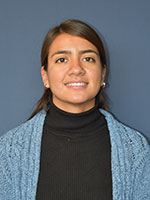Cisneros Miriam
Meet the team
Miscellaneous Information
- Miscellaneous Information
-
Bachelor's & Master's studies
I did my bachelor's studies in Electronics Engineering at the Durango Institute of Technology (ITD) in Durango, Mexico. I was very motivated to continue applying my new knowledge in the astronomical field, which I always found a fascinating topic, so I enrolled at the National Institute of Astrophysics, Optics and Electronics (INAOE), in Puebla, Mexico. I obtained my Master's in Science Degree specializing in Astrophysics in 2016.
During my Master's studies, I worked on the integration and characterization of the cryogenic system of MEGARA, as well as in the alignment of its CCD. MEGARA (Multi-Espectrografo en GTC de Alta Resolucion para Astronomia) is an optical Integral-Field Unit (IFU) and Multi-Object Spectrograph (MOS) currently in operation at the 10.4m Gran Telescopio de Canarias, in La Palma, Spain.
Before starting my Ph.D., I decided to work on small tasks at different projects, such as:
- the switch control system for calibration of Sci-HI (Cosmological Probe for the Detection of Neutral Hydrogen), at INAOE;
- part of the optical model in Python of ASPIICS/PROBA-3 (Association of Spacecraft for Polarimetric and Imaging Investigation of the Corona of the Sun) at the Royal Observatory of Belgium (ROB);
- the optomechanical design and thermal analysis of the IRSI/AMS (Infrared Spectral Imager for the Agricultural Monitoring System) telescope, in Cosine, the Netherlands;
- and the optomechanical design of the Mid-Infrared telescope for a CubeSat for solar monitoring at INAOE.
All these research stays helped me to define what I wanted to work on during my Ph.D. studies, so I finally joined the Royal Belgian Institute for Space Aeronomy (BIRA-IASB) in 2018.
Ph.D. studies
At BIRA-IASB, I worked in collaboration with the B.RCLab in the design, development, and implementation of a radiometric characterization facility for space-based visible (VIS) and near-infrared (NIR) detectors. This facility was used for the characterization of the flight and spare models of the VIS-NIR detectors of the Moons And Jupiter Imaging Spectrometer (MAJIS) on board the Jupiter ICy Moons Explorer (JUICE), which was launched on April 2023 and is planned to arrive to the Jovian System in 2031.
In the meantime, I learned a lot about the Jovian System, especially Jupiter's Atmosphere, so I'm currently working on the implementation of the modeling of Jupiter's Atmosphere in our Radiative Transfer code, ASIMUT-ALVL. Once this model is validated, it will be possible to support the MAJIS team in the analysis of the impact of MAJIS on the scientific observations of Jupiter.
I would like to continue working on Planetary Sciences concerning giant planets, without disconnecting from the instrumental part that keeps me on the bridge of the development of new instruments to continue advancing in the science of the objects we want to understand.







